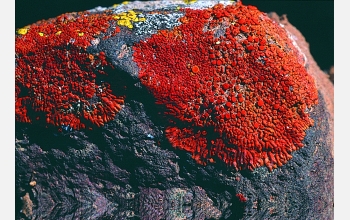Multimedia Gallery
Fire-red Lichen Caloplaca ignea
Fire-red lichen species Caloplaca ignea grows on small pebbles along the coast of Baja, Calif.
Lichens are actually made up of two plants, an algae and a fungus, living in a symbiotic relationship. In desert environments, lichen will dry out completely and remain dormant until rain or dewfall provides enough moisture to make them active again. This ability allows lichens to survive some of the harshest environments on the planet. Lichens are very sensitive to air pollution. Scientists rely on them as a bioindicator species, like a natural early warning system.
Plant biologist Thomas Nash has spent a career studying lichens, the crusty mats of blue and green and orange often seen covering desert rocks. The Lichen Herbarium at Arizona State University is home to 90,000 specimens collected over 30 years by Nash and his colleagues. Supported by the National Science Foundation, Nash and 70 scientists from 16 countries have spent more than 14 years documenting all the lichen species found in the Sonoran Desert region. More than 40 percent of the lichens known to North America live in the Sonoran Desert and surrounding regions. They recently completed volume I of the first comprehensive account of all lichen species known from the Southwest, including large parts of northwestern Mexico.
Volume I of "Lichen Flora of the Greater Sonoran Desert Region" covers nearly 600 species of lichen in more than 140 genera. The volume is co-edited by Nash, Bruce D. Ryan, Corinna Gries and Frank Bungartz. The book offers identification keys and descriptions for each species treated, as well as maps showing species distribution. For details, visit http://nhc.asu.edu/lherbarium/flora/order.php. (Year of image: 2002) [Image 2 of 5 related images. See Image 3.]
Credit: ©Frank Bungartz, Ph.D., Arizona State University Lichen Herbarium
Special Restrictions: The owner has restricted use of this image. Permission is granted to use the image for personal, educational or nonprofit/non-commercial use only and only after sending and e-mail notifying your intent to use to frank.bungartz@asu.edu. Permission to use this image in any other manner is prohibited without prior permission from the owner.
Images and other media in the National Science Foundation Multimedia Gallery are available for use in print and electronic material by NSF employees, members of the media, university staff, teachers and the general public. All media in the gallery are intended for personal, educational and nonprofit/non-commercial use only.
Images credited to the National Science Foundation, a federal agency, are in the public domain. The images were created by employees of the United States Government as part of their official duties or prepared by contractors as "works for hire" for NSF. You may freely use NSF-credited images and, at your discretion, credit NSF with a "Courtesy: National Science Foundation" notation.
Additional information about general usage can be found in Conditions.
Also Available:
Download the high-resolution TIFF version of the image. (3.4 MB)
Use your mouse to right-click (Mac users may need to Ctrl-click) the link above and choose the option that will save the file or target to your computer.



